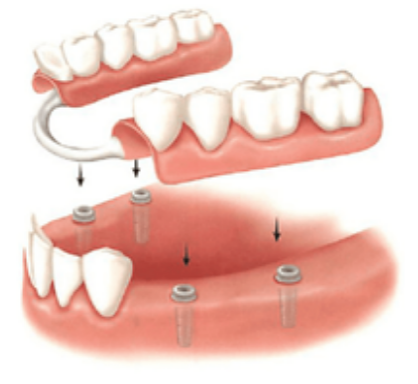Missing one or Multiple Teeth
Single Tooth Dental Implant Solution
When a single tooth is missing, the most common treatment options are the conventional tooth supported bridge or a dental implant. A dental implant provides several advantages over other tooth replacement options. In addition to looking and functioning like a natural tooth, a dental implant replaces a single tooth without sacrificing the health of neighboring teeth. The fabrication of a fixed bridge, requires that adjacent teeth be ground down to peg shapes in order to support the cemented bridge in place.
In the long term, a single implant can be more cosmetic and easier to keep clean than a bridge. Gums can recede around a bridge, leaving a visible defect when the metal base or collar of the bridge becomes exposed. Resorbed bone beneath the bridge can lead to an unattractive smile. And, the cement holding the bridge in place can wash out, allowing bacteria to decay the teeth that anchor the bridge. Dental implants are made of medical grade titanium. As such, they are not subject to tooth decay (cavities). A dental implant does not have a root canal so there will never be a need for root canal treatment which may be needed after a bridge is made. Every case is different. The space, gum tissue and underlying bone must be appropriate to place the dental implants. When you schedule your CONSULTATION, we can determine if you are a suitable candidate for implant to replace your missing tooth.
Treatment Options for Multiple Missing Teeth

When multiple teeth are missing, teeth may be replaced with either traditionally fixed bridgework supported on the remaining teeth, or with a removable partial denture that is held in place by claps on the remaining teeth, or with implant restorations.
The benefits of implants in the case of missing multiple teeth are ever greater than those in the single tooth replacement scenario. The traditional removable partial denture tends to accelerate bone loss because of undue pressure on the gum tissue. In addition, these prostheses are hooked to the remaining teeth with metal or plastic clasps that exert excessive loads on the teeth causing accelerated loosening and tooth decay. When surveyed, many patients with partial dentures show that their partials are generally uncomfortable. They generally express overall dissatisfaction with their partial denture wearing experience and daily quality of life activities such as eating, speaking, and being intimate with their partners.
Replacing multiple missing teeth can be accomplished through multiple single-tooth implant restorations , or with implant bridges where two or more implants can replace three or more teeth. Implant bridges enable us to avoid the need to shave down the adjacent teeth and fabrication of long span bridges supported by natural teeth. They do not require an implant for every missing tooth. The space, gum tissue and underlying bone must be appropriate to place the dental implants. When you schedule your consultation, we can determine if you are a suitable candidate for implant bridges to replace your missing teeth.
Another option to replace multiple missing teeth is the implant-assisted removable partial dentures (IRPD). Instead of making a partial denture that sits on the gum tissue and hook on the teeth, these partials rely on a few implants placed in strategic positions which help make the removable partial denture more secure. The addition of the implants helps to eliminate unsightly clasps, reduces the display of metal parts, and increases the security of the denture as it is held in place.

